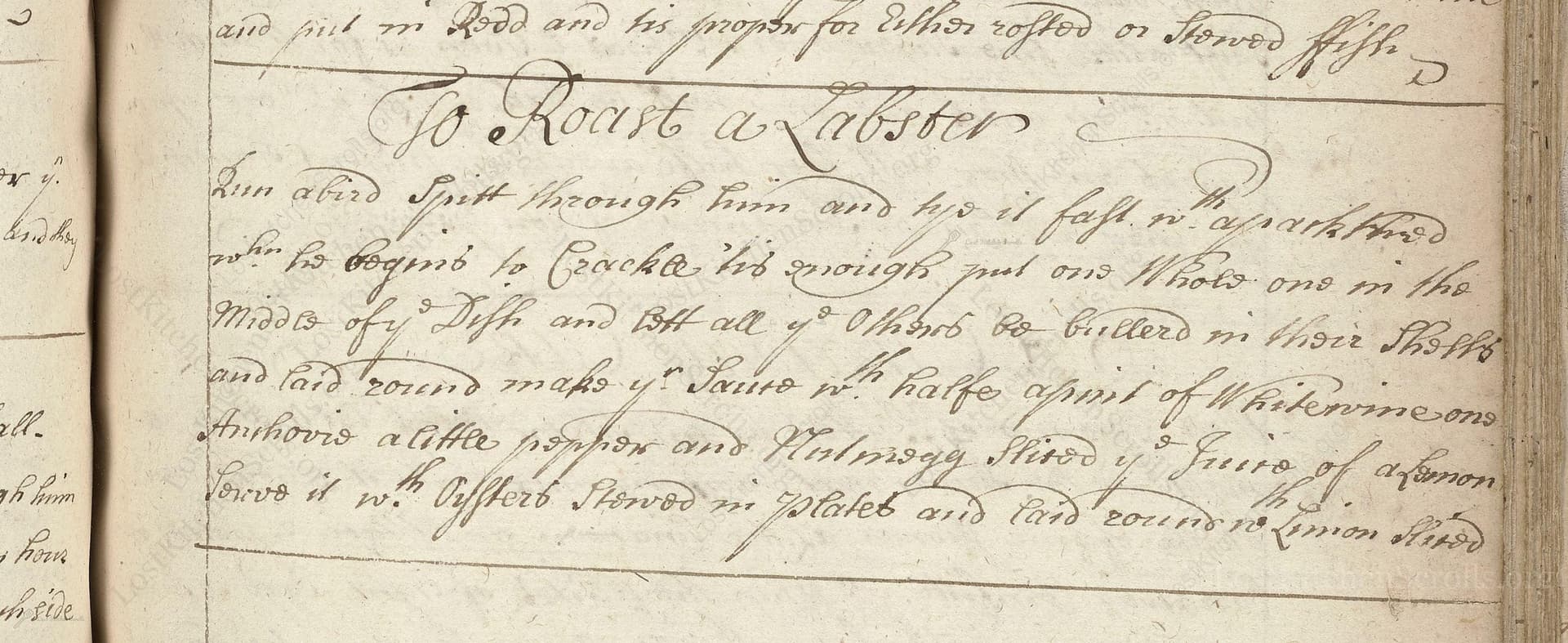To Roast A Lobster
From the treasured pages of Cookbook of Grace Blome, Kent
Written by Grace Randolph

To Roast A Lobster
"Run a bird Spitt through him and set it fast in a park hook when he begins to Crackle 'tis enough put one Whole one in the middle of ye Dish and lett all ye Other be broiled in their Shells and laid round make yr Sauce wth halfe a pint of Whitervine one Anthovie a little pepper and Nutmegg Sliced & Juice of a Lemon melt it wth fresh Butter and pour on him then Serve it wth Oysters Stewed in plates and round no Lemon sliced"
Note on the Original Text
The recipe is a typical late 17th-century 'receipt,' using a brief, imperative style, with spelling and grammar reflecting early modern English ('run a bird spitt through him,' 'set it fast in a park hook'). The lack of quantities is typical, assuming the reader's experience. Unfamiliar words: 'Anthovie' is 'anchovy,' 'Whitervine' is 'white wine.' Some elements like broiling and saucing are left to the cook's discretion, reflecting the practice of teaching through demonstration rather than precise written guidance.

Title
Cookbook of Grace Blome, Kent (1697)
You can also click the book image above to peruse the original tome
Writer
Grace Randolph
Era
1697
Publisher
Unknown
Background
A delightful glimpse into late 17th-century kitchens, this culinary collection by Grace Randolph tempts taste buds with refined recipes and elegant flavors fit for a well-to-do English household. Journey through a banquet of historic treats and timeless techniques!
Kindly made available by
Folger Shakespeare Library
This recipe comes from Grace Randolph's late 17th-century household manuscript, dated to around 1697 in England. During this period, lobster was a prized ingredient, accessible to upper-class households, and roasting it was seen as a show-stopping centerpiece. The sauce, blending white wine, anchovy, lemon, spices, and butter, reflects the emerging French influences in British cuisine at the time. Oysters were common and affordable, often served as starters or garnishes for elaborate meals.

Cooks in Randolph's time used a spit—a long metal or wooden rod—to roast the lobster over an open hearth, with hooks and racks to turn and secure the shellfish. A 'park hook' (pot hook) held the spit in place. Small pans and ladles were used to melt butter and mix sauces. Broiling shells would be done over hot coals or on a hearthstone. Oysters would be stewed in small pewter or earthenware plates right in the embers.
Prep Time
20 mins
Cook Time
15 mins
Servings
3
We've done our best to adapt this historical recipe for modern kitchens, but some details may still need refinement. We warmly welcome feedback from fellow cooks and culinary historians — your insights support the entire community!
Ingredients
- 2-3 whole live lobsters (about 1–1.5 lb each)
- 1 cup dry white wine
- 1 anchovy (or 1/2 tsp anchovy paste)
- 1/4 tsp ground black pepper
- Pinch of ground nutmeg
- Juice of 1 lemon
- 1/4 cup fresh unsalted butter
- 1 lb fresh oysters, shucked (for serving separately)
- Whole lemon (for serving, not sliced)
Instructions
- To recreate 'To Roast a Lobster' in a modern kitchen, begin by skewering a whole live lobster lengthwise with a metal spit or heavy skewer.
- Secure the lobster over a grill, open fire, or under the broiler, turning carefully until the shell turns bright red and you hear it 'crackle'—indicating it is just cooked through (about 10-15 minutes, depending on size).
- Remove and place the whole roasted lobster in the center of a serving platter.
- For the rest of the lobsters, split them and broil or grill them in their shells until the meat is opaque and tender.
- Arrange these around the central lobster.
- Prepare the sauce by gently heating 1 cup dry white wine, one anchovy (or 1/2 tsp anchovy paste), a dash of ground pepper, a pinch of freshly ground nutmeg, and the juice of one lemon.
- Whisk in about 1/4 cup unsalted butter until emulsified, but do not boil.
- Pour this sauce over the lobster.
- Serve the dish alongside oysters, gently stewed or warmed in small plates, with whole lemon (not sliced) for squeezing at the table.
Estimated Calories
410 per serving
Cooking Estimates
Preparing the ingredients, including cleaning and splitting the lobsters, takes about 20 minutes. Cooking the lobsters and making the sauce takes 15 minutes. Each serving (1/3 of the total) contains around 410 calories.
As noted above, we have made our best effort to translate and adapt this historical recipe for modern kitchens, taking into account ingredients nowadays, cooking techniques, measurements, and so on. However, historical recipes often contain assumptions that require interpretation.
We'd love for anyone to help improve these adaptations. Community contributions are highly welcome. If you have suggestions, corrections, or cooking tips based on your experience with this recipe, please share them below.
Join the Discussion
Rate This Recipe
Dietary Preference
Main Ingredients

Den Bockfisch In Einer Fleisch Suppen Zu Kochen
This recipe hails from a German manuscript cookbook compiled in 1696, a time whe...

Die Grieß Nudlen Zumachen
This recipe comes from a rather mysterious manuscript cookbook, penned anonymous...

Ein Boudain
This recipe comes from an anonymous German-language manuscript cookbook from 169...

Ein Gesaltzen Citroni
This recipe, dating from 1696, comes from an extensive anonymous German cookbook...
Browse our complete collection of time-honored recipes



